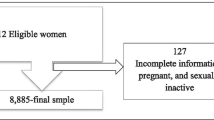Abstract
Uptake of contraceptives is generally low in low-income settings. For women with HIV, contraception is a reliable and affordable method of minimizing vertical transmission. We investigated the factors that affect contraceptive use among Kenyan women using data collected during the Kenya Demographic & Health Survey (KDHS) of 2014. Data on contraceptive use were extracted from the 2014 KDHS database. Records of 31,079 Kenyan women of reproductive age (15–49 years) were analyzed. Frequencies were calculated; cross-tabulations and bivariate and multivariate analyses were conducted. Twelve thousand thirty-two women (39%) reported using a contraceptive method. Region, religion, education, number of living children, marital status, and prior testing for HIV were significantly associated with contraceptive use among women (P < 0.001). Social, economic, and demographic factors predict contraceptive use among Kenyan women and should be addressed in order to increase contraceptive uptake.
Similar content being viewed by others
References
World-fertility-patterns-2015.pdf [Internet]. http://www.un.org/en/development/desa/population/publications/pdf/fertility/world-fertility-patterns-2015.pdf. Accessed 9 April 2018.
Sharan M, Ahmed S, May J, Soucat A. Family planning trends in Sub-Saharan Africa: progress, prospects, and lessons learned. Baltimore, Maryland: Johns Hopkins Bloomberg School of Public Health; 2010.
Ssali A, Namukwaya S, Bufumbo L, et al. Pregnancy in HIV clinical trials in sub Saharan Africa: failure of consent or contraception? Sued O, editor. PLoS ONE. 2013;8(9):e73556.
Berhane Y, Berhe H, Abera GB, Berhe H. Utilization of modern contraceptives among HIV positive reproductive age women in Tigray, Ethiopia: a cross sectional study. ISRN AIDS [Internet]. https://www.ncbi.nlm.nih.gov/pmc/articles/PMC3800562/. Accessed 25 Sept 2013.
Wekesa E, Coast E. Contraceptive need and use among individuals with HIV/AIDS living in the slums of Nairobi, Kenya. Int J Gynecol Obstet. 2015;130:E31–6.
Joshi B, Velhal G, Chauhan S, et al. Contraceptive use and unintended pregnancies among HIV-infected women in Mumbai. Indian J Commun Med. 2015;40(3):168–73.
Ezugwu EC, Iyoke CA, Nkwo PO, Ezegwui HU, Akabueze JC, Agu PU. Unintended pregnancy among HIV-positive pregnant women in Enugu, southeast Nigeria. Int J Gynaecol Obstet. 2016;132(1):60–3.
Yotebieng M, Norris A, Chalachala JL, Matumona Y, Ramadhani HO, Behets F. Fertility desires, unmet need for family planning, and unwanted pregnancies among HIV-infected women in care in Kinshasa, DR Congo. Pan Afr Med J [Internet]. https://www.ncbi.nlm.nih.gov/pmc/articles/PMC4919670/. Accessed 2015
Muma J, Kabiru C, Mukiira C, et al. APHRC-country-step-up-report-Final.pdf [Internet]. http://aphrc.org/wp-content/uploads/2014/05/APHRC-country-step-up-report-Final.pdf. Accessed 29 April 2017.
Sirengo M, Muthoni L, Kellogg TA, et al. Mother-to-child transmission of HIV in Kenya: results from a nationally representative study. J Acquir Immune Defic Syndr. 2014;66(suppl 1):S66–74.
Ochako R, Mbondo M, Aloo S, et al. Barriers to modern contraceptive methods uptake among young women in Kenya: a qualitative study. BMC Public Health [Internet]. 2015;15(1). http://bmcpublichealth.biomedcentral.com/articles/10.1186/s12889-015-1483-1. Accessed 22 Feb 2017.
Kenya National Bureau of Statistics, Ministry of Health/Kenya, National AIDS Control Council/Kenya, Kenya Medical Research Institute, National Council for Population and Development/Kenya. Kenya Demographic and Health Survey 2014. 2015. http://dhsprogram.com/publications/publication-fr308-dhs-final-reports.cfm. Accessed 29 April 2017.
Saliku T, Ochako R, Izugbara C. Use of contraceptives among women in Nairobi, Kenya [Internet]. 2011. http://www.abortionresearchconsortium.org/reports/APHRC-policy-brief-26.pdf. Accessed 29 April 2017.
Najafi-Sharjabad F, Syed Yahya SZ, Rahman HA, Hanafiah M, Abdul Manaf R. Barriers of modern contraceptive practices among asian women: a mini literature review. Glob J Health Sci. 2013;5(5):181–92.
Kabagenyi A, Jennings L, Reid A, Nalwadda G, Ntozi J, Atuyambe L. Barriers to male involvement in contraceptive uptake and reproductive health services: a qualitative study of men and women’s perceptions in two rural districts in Uganda. Reprod Health. 2014;11(1):21.
Apanga PA, Adam MA. Factors influencing the uptake of family planning services in the Talensi District, Ghana. Pan Afr Med J [Internet]. 2015;20. http://www.panafrican-med-journal.com/content/article/20/10/full/. Accessed 29 April 2017.
Mosha I, Ruben R, Kakoko D. Family planning decisions, perceptions and gender dynamics among couples in Mwanza, Tanzania: a qualitative study. BMC Public Health. 2013;13(1):523.
Haddad LB, Polis CB, Sheth AN, et al. Contraceptive methods and risk of HIV acquisition or female-to-male transmission. Curr HIV/AIDS Rep. 2014;11(4):447–58.
Acknowledgement
We wish to acknowledge support from the University of California, San Francisco’s International Traineeships in AIDS Prevention Studies (ITAPS), U.S. NIMH, and R25MH064712. International Aids Vaccine Initiative, Kenya Aids Vaccine Initiative-Institute of Clinical Trials, Measure DHS, and Kenya National Bureau of Statistics We wish to acknowledge Debbie Bain Brickley for her invaluable contribution towards this paper.
Author information
Authors and Affiliations
Corresponding author
Ethics declarations
Conflict of interest
The authors declare that the research was conducted in the absence of any commercial or financial relationships that could be interpreted as potential conflict of interest.
Ethical Approval
We made a request to MEASURE DHS (Monitoring and Evaluation to Assess and Use Results of Demographic and Health Surveys program) for authorization to work on the KDHS 2014 data set. This was granted and a link to access the data set was provided.
Informed Consent
Secondary data collected by DHS program was utilized for analysis in this study. Therefore ethical approval and consent for participating was not applicable.
Rights and permissions
About this article
Cite this article
Lunani, L.L., Abaasa, A. & Omosa-Manyonyi, G. Prevalence and Factors Associated with Contraceptive Use Among Kenyan Women Aged 15–49 Years. AIDS Behav 22 (Suppl 1), 125–130 (2018). https://doi.org/10.1007/s10461-018-2203-5
Published:
Issue Date:
DOI: https://doi.org/10.1007/s10461-018-2203-5




